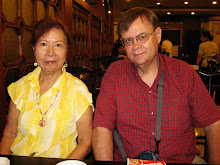We bought a pound of this tea from the same vendor who sold us the Longjing tea. She assured us that it came from Jiangsu Province. Once again, I question whether this tea actually came from Dongting because of its price. It is expensive but not as expensive as I found on the internet.
We had the pound split into two separate bags, one for us and one to take back to Thailand. Today I finally opened "our" bag to give it a try..
 The leaves are very light and are, indeed, curled up like little snails. The leaves appear to be very young. One gets a lot of tea for the weight.
The leaves are very light and are, indeed, curled up like little snails. The leaves appear to be very young. One gets a lot of tea for the weight. This is a hairy tea. The color is about the same color and look about he same weight as that of Mao Fengs and Yun Wus. Light, delicate with hair. This tea, however, had more green than the others.
This is a hairy tea. The color is about the same color and look about he same weight as that of Mao Fengs and Yun Wus. Light, delicate with hair. This tea, however, had more green than the others.  The liquid is light and golden hued. The taste is magnificent and reminded me of peach blossoms. No doubt about it, this tea grew up around peach trees.
The liquid is light and golden hued. The taste is magnificent and reminded me of peach blossoms. No doubt about it, this tea grew up around peach trees. Both this tea and the Longjing tea reminded me of spring water with a refreshing aftertaste of sweetness and purity. Both these teas are well worth what we paid for them. They are totally different than any of the green teas we have been drinking from Emei Mountain. Sweet, delicate and floral without a hint of bitterness to them. We will definitely buy more of these two teas next week when we return to the Tea Culture Town in Chengdu.
 I was able to get a good solid five infusions out of the leaves. I do think, however, that I started with too fews leaves as I had to wait an addition minute or so to get a good taste of the tea. This is simply as good as it gets in tea drinking. If this means I have become a snob, then so be it. I love this tea.
I was able to get a good solid five infusions out of the leaves. I do think, however, that I started with too fews leaves as I had to wait an addition minute or so to get a good taste of the tea. This is simply as good as it gets in tea drinking. If this means I have become a snob, then so be it. I love this tea.


No comments:
Post a Comment